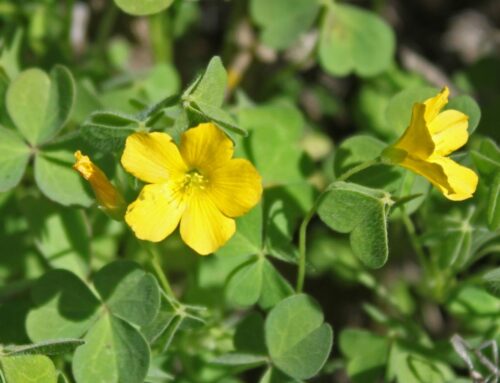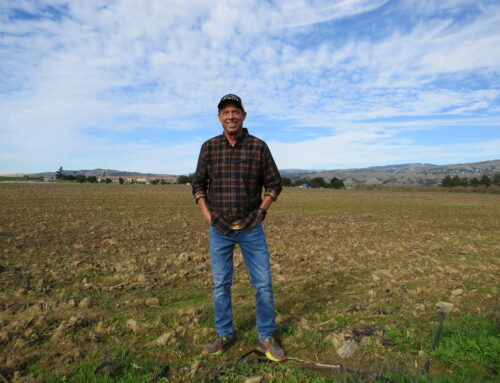Many water sources used by animals have dried up
Published in the November 11-24, 2015 issue of Morgan Hill Life
By Geoff Kober

Del Foster, Pamela Gallo and Mateo Gallo hike the Monument Trail at Henry W. Coe State Park during the 2015 Tarantula Fest. The drought has impacted local outdoor enthusiasts because as nature’s once reliable water sources have dried up, wildlife populations — and sightings — have fluctuated or in some cases disappeared.
Photo by Geoff Kober
A gentle breeze swayed the sun-saturated grasses in Henry W. Coe State Park as Del Foster, Pamela Gallo and her son Mateo crunched over a layer of dried pine needles blanketing the park’s Monument Trail. All avid hikers, they came to the park for exercise and to enjoy the wildlife in the scenic oak savanna just a few miles east of their home in Morgan Hill.
With California in the fourth year of a historic drought, Foster observed some significant changes in the landscape from his past trips to the park. “The trees look a lot drier,” he said. “Things are looking so much drier than they have in the past.”
The Morgan Hill residents were attending Coe’s Tarantula Fest, an event in which visitors learn about the hairy arachnids and other wildlife in the park. The drought has impacted local outdoor enthusiasts because as nature’s once reliable water sources have dried up one by one, wildlife populations — and sightings — have fluctuated. The scenery for local hikers has changed, too, as pressure from insect pests has devastated trail-side pine trees and the risk of wildfires has escalated in their favorite open spaces.
There have been throughout the decades cycles for wildlife sightings as many of Santa Clara County’s springs and water pools slowly dry up during the summer and fall. During this extended drought, however, locations that have been old standbys for wildlife sightings have changed or disappeared along with the water sources, said Henry W. Coe Park Ranger John Verhoeven. Sierra View, a campsite about a mile from the park headquarters, has a spring that “normally doesn’t dry out. But it’s been drying up for the last three years,” he said. The various animals visitors might normally see are now scarce.
During the drought, animals depend on ponds, remaining flowing springs and various water troughs the park volunteers set up in Coe. “The water table has got to be dropping for springs to dry out, so that affects the animals,” Verhoeven said. “They have to go somewhere else to find water.”
In order to successfully reproduce, the threatened black and yellow spotted California Tiger Salamander and the endangered California Red Legged Frog require water sources that remain throughout a typical dry season. Galli Basson, the resource management specialist at the Santa Clara Valley Open Space Authority, has worked to preserve these seldom-seen amphibians. “Some of our ponds that used to be wet year around, or at least until the end of the summer, have dried up a lot sooner,” she said. “If the ponds are drying up too fast, then these rare species are not able to successfully breed.”
The Western Pond Turtle, with its deep-olive colored carapace, is the only native freshwater turtle throughout a habitat ranging from Washington to Baja California. Joseph Belli, a volunteer at Coe Park since 1993, has devoted many hours to studying these exceedingly shy reptiles. He has carried out behavioral research on Western Pond Turtles in the Coyote Creek Watershed and observed changes that may be linked to the reduced rainfall since 2011.
“[Western Pond Turtles] have a strategy where as the stream dries they actually leave the stream bed and move up into the oak woodlands,” he said. “The mean date for the turtles leaving in 2011 was early to mid-August, and in 2013 it was pushed up about six weeks, a substantial difference.”
Belli explained that as urban development expands into open space, it divides populations into “islands.” This increases the difficulty for native species to repopulate after a natural disaster. “The world has changed and animal populations have become fragmented because of urbanization,” he said. “With droughts, these small populations are no longer connected to larger populations that can replenish them later. Urbanization undermines populations so that when they also face natural climate fluctuation, the species get weaker and weaker.
A protected open space for wildlife in Santa Clara County, 89,000-acre Coe is California’s second largest state park. About 40,000 people visit the park each year to enjoy the outdoors, primarily to hike. Because of the extended drought, Ranger Verhoeven advises hikers to plan ahead. “We advise people to bring more water than normal,” he said. “Modest springs that used to regularly flow have dried up. We are in an intense dry cycle, and the water table is down.”
Even with the drought, summer hikers may have noticed few changes to the park’s plant species. Winslow Briggs, a Stanford University plant biologist, has been observing seasonal and climatic cycles in Coe since helping to found the park’s Pine Ridge Association volunteer group in the 1970s.
“For the most part, the plants are remarkably resilient,” he said. However, upon closer inspection, “the pines have clusters of dead needles behind the live needles and are producing huge numbers of cones, a sign that the tree is stressed.”
Two of South Valley’s native pine tree species are extremely sensitive to the drought, Briggs said. With normal rainfall, both Gray and Ponderosa pine trees are capable of producing pitch, a sticky resin under their bark. This process, however, is hindered during the drought, leaving the trees vulnerable to pests. Hordes of tiny black bark beetles are devastating the pine trees throughout Santa Clara County’s open space.
Coe adventurers will notice a significant change in the area’s temperature after trees are lost to bark beetles. “If an area is deforested,” Briggs said, “the temperature rises dramatically,” and the loss of cover can persist. “If we lose our pines, I don’t know what plants will replace them, but the environment is clearly going to get warmer as a consequence.”
In April 2015, the U.S. Forest Service and U.S. Department of Agriculture collaborated on a Forest Health Protection Survey. This overview reported that at least 12 million trees have died in California in response to the extreme drought. The massive die-off of trees resulting from dropping water tables and invading Pine Bark Beetles is causing an even greater threat: forest fires, said Pam Temmermand, a fire prevention specialist for the Santa Clara Cal Fire unit.
“Once they kill the trees off, it’s adding more fuel to any potential fires that come through the area,” she said. “The trees are literally dying off, progressing closer and closer to town to the trees that haven’t been affected yet.”
The encroachment of wildfire fuel into urban and suburban environments makes it necessary for local homeowners to take even greater precautions to prevent fires during a drought, Temmermand said.
So far this year, Cal Fire has reported 5,741 wildfires in California covering a total of 306,427 acres. There haven’t been any large fires this year in the South Valley, Temmermand said.
An increase in rainfall if El Niño comes through in the 2015-2016 rainy season could help prevent more devastating wildfires, she said.
“As far as the fire situation, any rain we get is fantastic,” she said. “I think we will have to see what’s going to happen, and hopefully, depending upon how much we get, it will help us and diminish some of these extra fires that we are getting.”
In a September 2015 report, the National Oceanic and Atmospheric Administration projected California will need nearly 200 percent of its average precipitation to allow substantial recovery from the drought.
The predicted rain is likely to have its own negative environmental impacts throughout Santa Clara County, said the OSA’s Galli Basson. An example might be Coyote Valley, where damaged roads and trails could require extra management by the OSA.
“Having a large amount of water certainly creates some extra management that we are preparing for,” she said. “Overall, we are pretty relieved at the possibility we are going to finally have some water.”
Until the rainfall begins in earnest this winter season, ushering in the potential for both drought relief and extreme water damage, Foster, Gallo, and Mateo will continue visiting Santa Clara County’s open space. They plan to keep enjoying their regular exercise and (diminished) wildlife sightings. But they also have the added anticipation of watching changes unfold.
“It will be interesting to see if rain this year makes any difference,” Foster said.
Geoff Kober is a San Francisco State University graduate. He wrote this for Morgan Hill Life as part three of a three-part series on the drought’s impact on South Valley.





